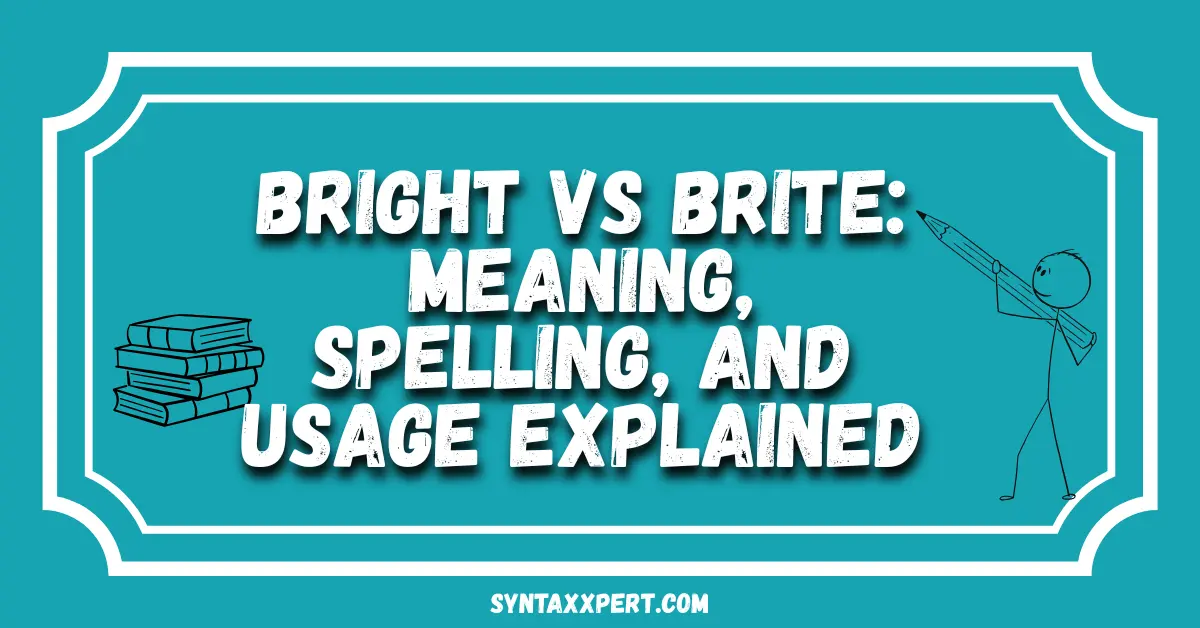When it comes to spelling, people often wonder about bright vs brite. The truth is simple: “bright” is the correct standard spelling you’ll find in every dictionary, while “brite” is a non-standard variation mainly used in branding, product names, and marketing. They sound the same, but the meaning and usage differ, and knowing when to use each can save you from awkward mistakes.
What Does “Bright” Mean?
The word bright is a well-established English adjective. It means something that shines with light, stands out in vivid color, or even describes an intelligent and cheerful person. For instance, you might say, “The stars are bright tonight” or “She has a bright future ahead.” It’s versatile and used across literature, science, daily conversation, and formal writing.
Beyond light and color, “bright” often carries a positive tone. Teachers may call a clever student “bright,” and travelers may admire a “bright morning.” Because of this wide acceptance, bright has an official place in dictionaries, grammar guides, and academic writing.
Examples of “Bright” in Sentences
- The sun was so bright it made me squint.
- He’s a bright child who loves solving puzzles.
- Her smile was bright enough to lift everyone’s mood.
What Does “Brite” Mean?
Unlike its counterpart, brite is not recognized as a standard English word. Instead, it’s a stylized spelling commonly used in brand names, advertising, or creative projects. Think of Scotch-Brite, Lite-Brite, or even modern startups that drop letters to sound unique.
This spelling exists for memorability and marketing, not for grammar. You won’t find it in serious academic papers or dictionaries, but you will spot it on store shelves and advertisements. In short, brite meaning is linked to style and branding, not formal English correctness.
Examples of “Brite” in Sentences and Brands
- I bought a pack of Scotch-Brite sponges.
- Kids love playing with the Lite-Brite toy.
- The company launched a new drink called “Brite Energy.”
Bright vs Brite: Key Differences
At first glance, bright vs brite might seem like a minor spelling tweak, but the difference is important. Bright is correct English spelling with accepted dictionary definitions, while brite is a creative alteration. Both sound identical (they’re homophones), but only one works in professional or academic contexts.
Whereas bright appears in essays, books, and daily communication, brite shows up in catchy product names. Think of it like choosing between a polished suit (bright) and a flashy neon jacket (brite)—both noticeable, but only one fits in a boardroom.
Bright vs Brite Comparison Table
| Feature | Bright (Correct) | Brite (Stylized) |
| Spelling Status | Standard English | Non-standard |
| Dictionary Entry | Yes | Rarely / Only in brand names |
| Meaning | Light, vivid, intelligent | Branding, stylized spelling |
| Usage | Academic, formal, everyday | Marketing, product names |
| Examples | A bright idea | Scotch-Brite, Lite-Brite |
Which Is Correct: Bright or Brite?
If you’re writing an essay, report, or professional email, the answer is clear—bright is the correct spelling. Using brite in formal writing looks like a typo and may confuse readers. Grammar guides and style experts agree that bright is the only acceptable choice outside brand names.
In casual or marketing settings, though, brite can serve a purpose. Designers and companies deliberately choose it to make products stand out. So while you shouldn’t replace bright with brite in everyday writing, you may encounter brite when it’s tied to trademarks or branding.
Is “Brite” a Real Word?
Not in the strict sense. Dictionaries may list “brite” only as a proper noun or stylized variant, not as a standard English word.
Why Do Companies Use “Brite”?
Marketers love breaking rules, and spelling is no exception. Companies use brite because it’s shorter, easier to trademark, and looks modern. Just as “lite” often replaces “light” in food packaging, brite has a punchy, eye-catching effect in logos and ads.
This trend works because consumers remember unusual spellings. For example, the cleaning sponge Scotch-Brite has become a household name, and Lite-Brite became a classic toy. In branding, brite means fun, creative, and memorable—even if it’s not “correct.”
The Role of Stylized Spellings in Branding
Creative misspellings like brite or lite stick in people’s minds. They look fresh, playful, and perfect for marketing, but they don’t belong in formal English contexts.
Common Mistakes with “Bright” and “Brite”
A frequent mistake is using brite where bright is required. For example, a student writing “The sky is brite” will lose marks because it’s considered a spelling error. Another common issue is readers assuming “brite” is slang or an acceptable informal spelling—it’s not.
Online, typos also drive searches like is brite a word or which is correct brite or bright. While search engines understand the connection, your boss or teacher might not. That’s why it’s safer to stick with the standard spelling unless you’re naming a product.
How to Avoid Mixing Up Bright vs Brite
A simple rule: if you’re writing for school, work, or publication, always use bright. Reserve brite for brand names or trademarks only.
Beyond Bright vs Brite: Other Creative Spellings in English
Brite vs bright isn’t the only case. English has plenty of creative spellings in ads and pop culture—lite vs light, nite vs night, thru vs through. These shortcuts may work in marketing but remain incorrect in formal writing.
Such spellings show how flexible English is in casual use, but when in doubt, always stick to the official spelling.
FAQs About Bright vs Brite
Are “Bright” and “Brite” Pronounced the Same?
Yes, they sound identical, which is why people confuse them.
Is “Brite” Accepted in Dictionaries?
Mostly no. Some may mention it in reference to trademarks, but not as a real word.
Can I Use “Brite” in Academic Writing?
No. Academic and professional writing requires bright.
Is “Brite” Slang or Just a Misspelling?
It’s neither slang nor a valid word—it’s simply a stylized variation used in names.
Why Do Ads Drop Letters Like in “Brite”?
Because unusual spellings make words stand out and are easier to trademark.
Final Thoughts: Bright vs Brite in Everyday Use
In the end, the difference is straightforward: bright is the correct word in English, while brite is a stylized spelling used for brands and ads. They sound the same, but only one belongs in your essays and emails.
So, if you want your writing to shine as brightly as the sun, stick with bright. Save brite for when you’re brainstorming your next big brand idea.

I’m Luna Hazel, a grammar expert here to help you master the art of clear, confident writing. Let’s make every word count!

